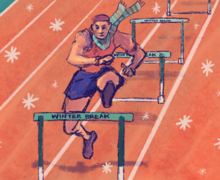Data Dive: Numbers that have defined Syracuse’s season at the bye week
Elizabeth Billman | Senior Staff Photographer
Syracuse football heads in the bye week 5-4. Here are some stats from its first nine games.
Get the latest Syracuse news delivered right to your inbox.
Subscribe to our sports newsletter here.
After being one loss away from a winless season in 2020, Syracuse heads into the bye week one win shy of a bowl berth for the first time since 2018.
This season has seen drastic improvement in all facets of the game for the Orange, but it still had its downs, too. SU lost three straight games by three points before its recent wins. Head coach Dino Babers said he has “unbelievable faith” in his team, which is led by the nation’s top running back in Sean Tucker and the 19th-best defense in the country, which is in its second season using the 3-3-5 system.
But to gain bowl eligibility, the Orange must win at least one of the three remaining regular season games against Louisville, NC State and Pittsburgh. Here are the stats to know about Syracuse heading into November:
All aboard the Tucker train
Tucker has been Syracuse’s spark on the offense, and he’s the best running back in all of college football. Tucker leads the nation in all-purpose yards (1,505) and all-purpose yards per game (167.22).
But the most surprising statistic has been his usage rate, which is at 37% through the nine games this season, according to College Football Data. On rushing attempts, he’s been used 55% of the time — the next closest player being quarterback Garrett Shrader at 37%, since he’s responsible for taking the ball on read option or designed quarterback runs.
“(Tucker) is different and the biggest waste that we can do is treat him like he’s not different,” Babers said about Tucker earlier in the season. “He’s something that doesn’t come along very often.”
The Orange only bring out other running backs sparingly, using Cooper Lutz and Abdul Adams for a combined 4% of running plays. Tucker also has 201 rushing attempts, the most of any college running back in the country. He averages 6.3 yards per carry, 20th-best nationally. At one point earlier this season, Tucker was responsible for the most scrimmage yards by any player in the Football Bowl Subdivision, providing 40.3% of Syracuse’s.
The only part of the game where he hasn’t been tapped into fully yet is in the receiving game, where he’s only been used 10% of the time. But Syracuse is 115th out of 130 FBS teams in passing yards per game, showing its leniency on Tucker. Against the Eagles, he wasn’t targeted once, instead torching his opposition with a career-high 207 rushing yards.
Special teams meltdown
Syracuse’s Special Teams U has fallen off its pedestal of being one of the best groups in the country. SU never even hired a special teams coordinator this year.
The Orange are ranked 97th out of 130 teams in the Special Teams Fremeau Efficiency Index, a metric used by Football Outsiders to calculate the efficiency ratings of all FBS teams. The rating combines kickoff return, kickoff, punt return, punt, field goal and opponent field goal efficiency into one number. SU was 14th-best in FBS last year, according to Football Outsiders, and now it’s 14th-best in the ACC.
Kicker Andre Szmyt has been at the forefront of this dropoff, falling from his 86.15% success rate over the last three seasons to a 58.3% success rate this year. From over 35 yards, Szmyt is 3-for-8 on the season, good for a 42.9% mark. He has missed easy attempts, too, including a 19-yard field goal and two extra points.

Maya Goosmann| Digital Design Director
Syracuse hasn’t been any better at punting either, using punters James Williams, Ian Hawkins and Colby Barker. Williams had been the main punter earlier in the season, but Barker went out for one punt against Rutgers, which only went eight yards past the line of scrimmage. Hawkins went out for one game against Florida State after Williams was out for unknown reasons, averaging 33.17 yards on six punts.
But overall, the punting unit averages 36.3 yards per punt, the worst mark in the ACC. This is one area where the Orange need to improve on in order to win close games, and hiring a special teams coach could be a step in the right direction.
Increased fourth down efficiency
Since 2016, Syracuse’s fourth down conversion rate decreased over 30%, falling to 31% at some point in 2020. Babers stopped going for it on fourth down in the opposing team’s territory, a trend that’s continued into this season.
Babers faced backlash for some controversial decisions early in the season, including once when he didn’t go for it on a crucial fourth-and-10 against Rutgers. Babers said it was a “50-50” decision, instead trusting his defense, which was unable to stop the Scarlet Knights. In the Orange’s first four games — when they were in their opposition’s territory — they only went for it once in four different situations. It worked against UAlbany, but the other three resulted in missed field goals by Szmyt.

Megan Thompson | Design Editor
But Babers started being more aggressive after nonconference play, going for it on fourth down three different times against Florida State. Although some of those attempts were successful, Babers has gone for it more in scoring situations, which is understandable given Szmyt’s struggles.
The Orange have a new arsenal of fourth down plays, including some passing setups that don’t rely on the legs of Shrader and Tucker. Syracuse has converted on 61.5% of its fourth-down attempts, second-best in the ACC.
Defensive explosions and mistakes
The defensive explosive rate is a metric that measures how often a defense prevents big plays from the opposition. Syracuse ranks seventh nationally, only allowing 8.49% splash plays. A big or explosive play has varying definitions, according to Action Network, but generally means at least a 10-20 yard gain on a play.
The lower the explosive rate is for a defense the better. Against the rush, Syracuse has a rating of 0.9, according to College Football Data. The reason for the Orange’s ability to stop big plays is their success at stopping the run, with the third-best rushing defense in the ACC, and its ability to pressure the quarterback — Syracuse leads the conference in total sacks with 33, resulting in losses of over 200 yards.
But the Orange’s success against the rushing attack is offset by their inability to stop big passing plays. College Football Data marks SU with 1.41 against the pass. Syracuse ranks 69th in team pass efficiency on defense nationally, allowing 191.1 passing yards per game.
Another defensive metric is havoc, which measures the percentage of plays in which the defensive generated a tackle for loss, pass deflection or turnover. According to College Football Data, the Orange only create havoc 5% of the time from their defensive backs compared to 15% from their front seven.
Syracuse cornerbacks Garrett Williams and true freshman Duce Chestnut have been beat on a lot of deep passes this season, as the duo only have a combined 13 pass breakups this year. Last week both Williams and Chestnut were beat on 40-plus yard passes, allowing Boston College to get into scoring range. Heading into the last three games of the year, the Orange need to improve the backbone of their defense so they don’t give up quick plays that can alter the result of key matchups.
Published on November 3, 2021 at 10:27 pm
Contact Anish: asvasude@syr.edu | @anish_vasu





